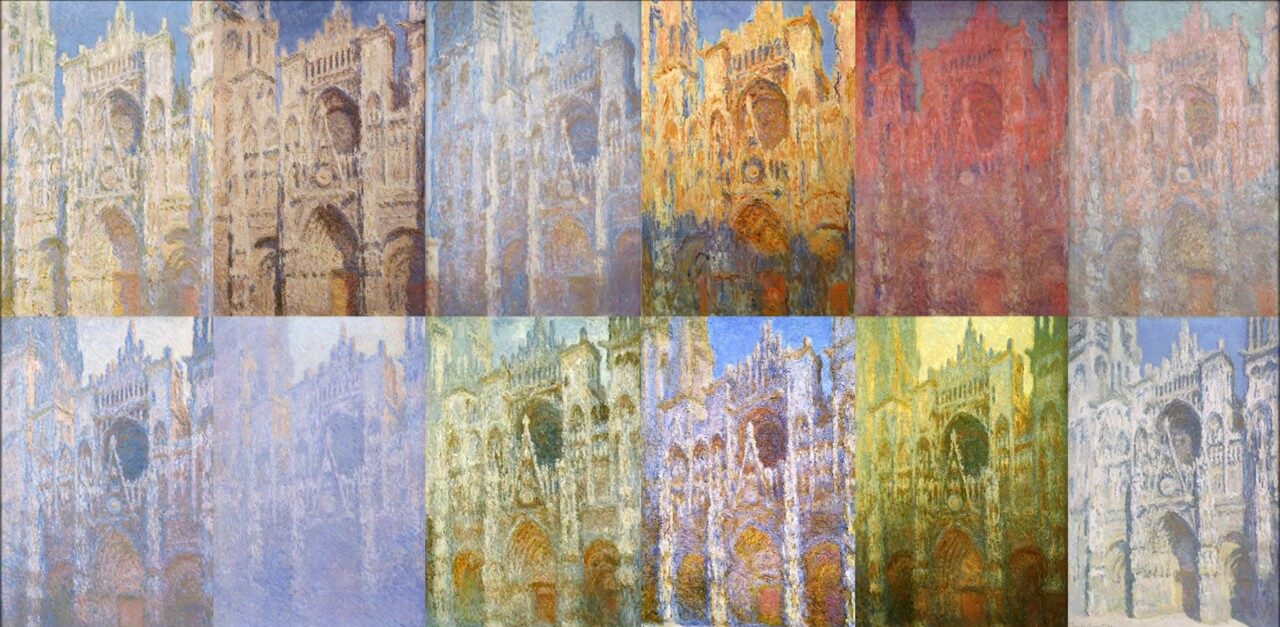Now I have a table of contents for my second book in skeleton form, I have been starting to sketch some of the flesh. This book, one focused on humanistic psychotherapy, will be more of a textbook than my first; but I still intend it to have a very personal flavour. Given the humanistic tradition rests upon individuality, it follows that therapists in this approach are encouraged to be themselves: to create a therapy that is unique to their own being. Consistent with this, when writing a book about humanistic psychotherapy I want to express a version that is peculiar to me and yet demonstrates a journey that has led to that coming into being. Things that I have found helpful in becoming a counsellor and being a psychotherapist.
I want to tackle something of that “counsellor – psychotherapist” arc in the book, and explore the debate how discrete the roles and associated activities are. I have been dipping into the roots of the humanistic tradition: both its humanistic psychology and continental philosophy* inputs. I don’t intend my book to provide a comprehensive history; but I know I need enough there to help start THE story of this “third wave”**, and to tell MY story within that. Therefore, in the time since arriving back from my writing retreat, I have been recalling and investigating the key players in the story, and reflecting upon what I have learnt from interacting with them and their theories.
Names like Abraham Maslow and Carl Rogers aren’t too far off the track for a general public, or at least those self-development wannabes. For instance, I first heard the name Maslow when training as a tennis coach as a teenager, and for sure it was a name that popped up the sport psychology modules at University. Carl Rogers (along with Freud) is probably the therapist we first come to meet on training courses across the “helping professions”. A name less known is that of Rollo May; and so to honour him in that founding trio, I started my writing project within a project (to write short essays on my influencers) with him.
Perhaps May’s biggest influence on me and my practice is within the realm of ‘anxiety’. It helped me truly establish the wisdom contained within and to invite me into relationship with it. Of course, May is not unique in the existential camp for speaking to this experience and its roots in our mortality; neither is he alone in stripping out the pathological view. What I really value is the advocacy for anxiety as the source of all creativity. I’ll let Rollo explain…
I have found myself more inspired of late to delve into May’s work; particularly his writings in “Courage to Create” as I settle into my own creative life. May’s mentor was Paul Tillich whose book “Courage to be” is one of my all time inspirational texts (Tillich will be another hero getting an essay in my book). I find my writing such a learning ground, a dialectical one, in the courage to create: how my writing both stokes and soothes my anxious being. I was particularly taken by re-engaging with May’s description of the “I am ‘experience'” within all of this – to be able to locate oneself as the “I am” and not the waveform experiencing of confidence and incompetence.
Starting out on the content writing and bringing focus to May coincided with a season of art for me. And through this fortuitous confluence, I decided to detour from Maslow, and instead fast forward to another essay planned for my book – a sharing of how much art has helped me truly understand phenomenology. I write in the book how I feel I have come to art – or at least a deeper appreciation of what it is (and isn’t) – relatively late in my life. In fact, I have in all honesty carried a little embarrassment as to how “un-cultured” I am. I would be the one in an art gallery, standing shoulder to shoulder with a friend looking at a canvas and thinking “I don’t get it…I bet they do” and being reluctant to share my experience of the exhibition. In my first draft of writing on how art can help us come to know our knowing, our sensate and perceptual experiencing, I reflect upon some key “a-ha” moments for me that also feel really critical in the “art of psychotherapy”: the difference between looking and seeing, subjective perception, intersubjectivity, knowing as a verb, intertwining and being-in-the-world. I’ll leave detail of that story and reflection for my book; for now, I wanted the excuse to show some art that has inspired me, and to acknowledge the great talent behind my learning.
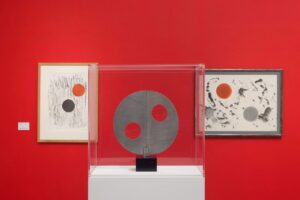 Attending the “art and life” of Barbara Hepworth last summer at the Towner gallery in Eastbourne felt pivotal in bringing art into how I think about psychotherapy: Influenced by my “critical friend” who was with me, and the concurrent reading of Bion. Again embarrassingly, I knew little about anti-nuclear campaigner and environmentalist Hepworth before going; but I certainly left feeling I had found a “champion of the feminine point of view” as she has also beed described. In the words of the exhibition “Deeply spiritual and passionately engaged with political and technological change, Hepworth focused on the dynamic physical encounter with sculpture and how this could allow the viewer to both reflect on and alter their perceptions and experiences of the world”. Something that struck deep, especially in the context of psychotherapy, was Hepworth’s attention to “three forms”.
Attending the “art and life” of Barbara Hepworth last summer at the Towner gallery in Eastbourne felt pivotal in bringing art into how I think about psychotherapy: Influenced by my “critical friend” who was with me, and the concurrent reading of Bion. Again embarrassingly, I knew little about anti-nuclear campaigner and environmentalist Hepworth before going; but I certainly left feeling I had found a “champion of the feminine point of view” as she has also beed described. In the words of the exhibition “Deeply spiritual and passionately engaged with political and technological change, Hepworth focused on the dynamic physical encounter with sculpture and how this could allow the viewer to both reflect on and alter their perceptions and experiences of the world”. Something that struck deep, especially in the context of psychotherapy, was Hepworth’s attention to “three forms”.
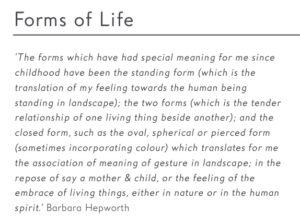
Though often depicted in abstract, these forms made me think about the three forms of “self, other, relationship”; a way we often think about the therapeutic dyad and the space between. Hepworth was often commended on her enduring ability to express essential human experiences “from interpersonal relationships to our connection to the world around us”. I found this in her work; and left feeling both intellectually stimulated and spiritually moved.
 The piece on the right is a photo taken of “Franklin summer”, a series of “automatic drawing” work by Yoko Ono at the recent Tate Modern’s “Music of the mind” exhibition. It was a fitting exhibition to attend with my meditation mentor given many of the exhibits were interspersed with and around Ono’s “Grapefruit” work: I had only known of this book (a series of Zen koan-like ‘instructions for life’) because I had seen a copy on my mentor’s bookshelf in the New York apartment I stayed in while training as a meditation teacher myself back in 2012. The Franklin Summer drawings particularly grabbed me (in the way Gego’s work did in my Manhattan visit described below) – not just the image that was created, but the way I came into connection through it: it was as if the ‘channelling like’ method drew me into the same aspect of mind. Again, Bion hovers “stage right” as I rest in that recollection. Regarding art in a state of reverie perhaps.
The piece on the right is a photo taken of “Franklin summer”, a series of “automatic drawing” work by Yoko Ono at the recent Tate Modern’s “Music of the mind” exhibition. It was a fitting exhibition to attend with my meditation mentor given many of the exhibits were interspersed with and around Ono’s “Grapefruit” work: I had only known of this book (a series of Zen koan-like ‘instructions for life’) because I had seen a copy on my mentor’s bookshelf in the New York apartment I stayed in while training as a meditation teacher myself back in 2012. The Franklin Summer drawings particularly grabbed me (in the way Gego’s work did in my Manhattan visit described below) – not just the image that was created, but the way I came into connection through it: it was as if the ‘channelling like’ method drew me into the same aspect of mind. Again, Bion hovers “stage right” as I rest in that recollection. Regarding art in a state of reverie perhaps.

David Hockney is the next recent teacher of phenomenology I would like to present. Hockney has played a part in my creative consciousness since a dear, now deceased, friend introduced me. Hockney’s book “Spring cannot be cancelled” helped me through my Normandy heartbreak when during the pandemic we were unable to make our usual spring trip there. I found out at that time that his residence there is only 20 minutes from where I normally stay! And so, while on writing retreat there recently and in Rouen for a “day-off” Easter Sunday, coming across his “Normandisme” exhibition was a delightful and unexpected surprise!
His work was being presented as part of the Normandy wide celebrations of 150 years of impressionism***. As well as his depictions of Spring and the 13 canvases in the “Moon room”, videos of his iPad work illustrated so superbly the mastery of the impressionist: the layers of mere “pixels” that build to give the “impression”. As a Buddhist and mediator, I could not help but make the parallels with the creation of a world through our perception. A mind forming gestalts. And all of this, positioned side by side with Monet. Now, whilst I was not brought up with art – Monet WAS the one exception. And back to Rollo May… “No matter how many times Monet returned to paint the cathedral at Rouen, each canvas was a new painting expressing a new vision.” In effect, those series of Rouen cathedral paintings tell us as much about Monet’s lived-experience as the building’s form.
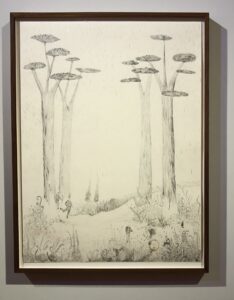
Next on my little art tour? Well, it would be remiss for an Eastbourne resident to NOT talk about the The Turner Prize as recently hosted by the Towner. I enjoyed meeting all four artists that were short listed: Jesse Darling (the eventual winner), Ghislaine Leung, Rory Pilgrim, and Barbara Walker. All gave me something to think about across the political, social, and ethical. Walker’s work perhaps most explicitly (in her work on power, identity and the black experience). I appreciated how both Darling and Pilgrim**** conveyed interconnectivity: with our environment, and with others. What I was really left however was the importance of art in our life; and yet also, I felt intrigued about the process of selecting a winner from these four, very different creators (and even, how did these four win selection onto the short list). Subjectivity and objectivity; another fascinating phenomenological pondering.
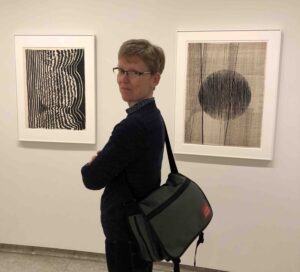
And final stop off, back to Manhattan where I had been this time last year (my blog, posted a year ago to the day!). I look back to my visit to the Guggenheim with one of my dear US friends who I met on my meditation teacher training there in 2012. A designer by training, and now a therapist in the Integral approach, my friend was again the right companion / right time. Looking at the art together, discussing our experiences; and doing so now with a different kind of attention. It was the first time I had come across German-Venezuelan visual artist, Gego. Right off the back of a four day mahamudra retreat, my looking to seeing to knowing continuum was being honed; and it gave me a taste of how much we (and our state of being) play a part in the experience of art. If “I don’t get it”, I am not getting “I am”. It was as if I was meant to meet Gego and her art forms that SO resonated with my experiences of mind as a field of awareness.
I doubt this will be the last time I write about art, phenomenology, and psychotherapy on this blog post. Bear with me as I wobble and find my new legs.
_______________
*which is why you will often see the label “existential-phenomenological” rather than “humanistic”
** after psychoanalysis and behaviourism
***Normandy makes a pretty good claim at being “the home of impressionism”
****It is one of Rory Pilgrim’s drawings featured on the left “Tomorrow’s gentle rain”

